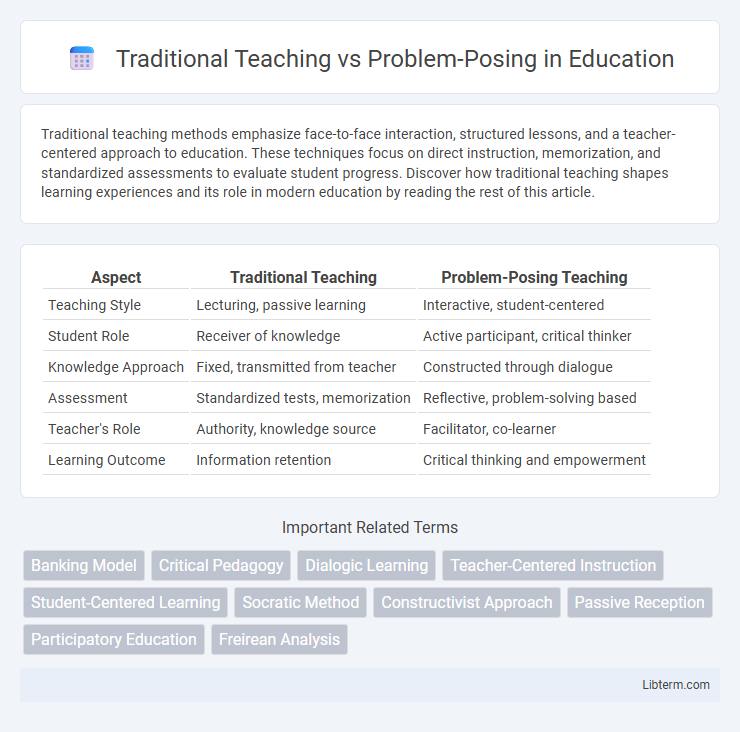Traditional teaching methods emphasize face-to-face interaction, structured lessons, and a teacher-centered approach to education. These techniques focus on direct instruction, memorization, and standardized assessments to evaluate student progress. Discover how traditional teaching shapes learning experiences and its role in modern education by reading the rest of this article.
Table of Comparison
| Aspect | Traditional Teaching | Problem-Posing Teaching |
|---|---|---|
| Teaching Style | Lecturing, passive learning | Interactive, student-centered |
| Student Role | Receiver of knowledge | Active participant, critical thinker |
| Knowledge Approach | Fixed, transmitted from teacher | Constructed through dialogue |
| Assessment | Standardized tests, memorization | Reflective, problem-solving based |
| Teacher's Role | Authority, knowledge source | Facilitator, co-learner |
| Learning Outcome | Information retention | Critical thinking and empowerment |
Introduction to Traditional Teaching and Problem-Posing
Traditional teaching centers on a teacher-led, lecture-based approach where knowledge is transmitted from instructor to student as definitive and fixed information. In contrast, problem-posing education encourages critical thinking by engaging students in dialogue and reflection to collaboratively explore and question concepts. This method cultivates active learning, empowering students to develop problem-solving skills rather than passively receiving content.
Defining Traditional Teaching Methods
Traditional teaching methods emphasize teacher-centered instruction where educators deliver content through lectures and rote memorization, prioritizing factual knowledge transfer. The approach often relies on standardized curricula and assessments designed to evaluate students' ability to recall information. This method limits student engagement and critical thinking by positioning learners as passive recipients rather than active participants in the educational process.
Understanding Problem-Posing Education
Problem-Posing education emphasizes active learning by engaging students in critical thinking and dialogue, contrasting with Traditional Teaching's focus on rote memorization and passive reception of information. This approach fosters deeper comprehension and equips learners with problem-solving skills essential for real-world applications. By encouraging reflection and inquiry, Problem-Posing cultivates a more participatory and transformative educational experience.
Historical Context and Origins
Traditional teaching, rooted in the early 20th century educational model, emphasizes rote memorization and teacher-centered instruction, reflecting a hierarchical classroom structure. Problem-posing education, developed by Paulo Freire in the 1960s, emerged as a response to oppressive pedagogies, advocating for critical thinking and student-teacher dialogue to empower learners. The historical context of postcolonial movements and social justice activism significantly shaped problem-posing methods as a transformative alternative to conventional didactic teaching.
Teacher-Centered vs Student-Centered Approaches
Traditional teaching emphasizes a teacher-centered approach where instructors deliver content directly, controlling the learning process and focusing on rote memorization. Problem-posing education shifts to a student-centered paradigm, encouraging critical thinking and active participation as learners engage with real-world problems. This method fosters deeper understanding by positioning students as co-creators of knowledge rather than passive recipients.
Classroom Dynamics and Student Engagement
Traditional teaching methods often emphasize teacher-centered instruction, where information flows unidirectionally and students primarily listen and memorize. Problem-posing education fosters active participation by encouraging students to question, analyze, and collaboratively solve real-world problems, thereby enhancing critical thinking and engagement. Classrooms adopting problem-posing dynamics tend to experience increased student motivation, deeper understanding, and interactive dialogue that supports democratic learning environments.
Critical Thinking and Knowledge Retention
Traditional teaching primarily relies on rote memorization and passive learning, often limiting critical thinking development and long-term knowledge retention. Problem-posing education encourages active engagement and inquiry, fostering deeper understanding and enhancing critical thinking skills. Research shows students in problem-posing environments retain knowledge more effectively due to meaningful participation and contextual learning.
Strengths and Limitations of Each Approach
Traditional teaching excels in structured knowledge delivery and efficient content coverage, fostering foundational skills through repetition and clear objectives. Problem-posing engages critical thinking and creativity by encouraging learners to question and explore real-world issues, enhancing deeper understanding and active participation. Traditional methods may limit student autonomy and creativity, while problem-posing can challenge curriculum pacing and require extensive teacher facilitation skills.
Real-World Applications and Outcomes
Traditional teaching emphasizes memorization and passive learning, often limiting students' ability to apply knowledge to real-world situations. Problem-posing education fosters critical thinking and engagement by encouraging learners to analyze and solve authentic problems, enhancing practical skills. This approach leads to improved outcomes in problem-solving abilities, creativity, and lifelong learning adaptability.
Choosing the Right Approach for Today’s Learners
Traditional teaching emphasizes rote memorization and teacher-centered instruction, which may limit critical thinking and creativity. Problem-posing pedagogy encourages active learner engagement by framing education as a dialogue that fosters critical reflection and problem-solving skills. Choosing the right approach depends on learners' needs, with problem-posing better suited for developing critical thinking in dynamic, real-world contexts.
Traditional Teaching Infographic

 libterm.com
libterm.com